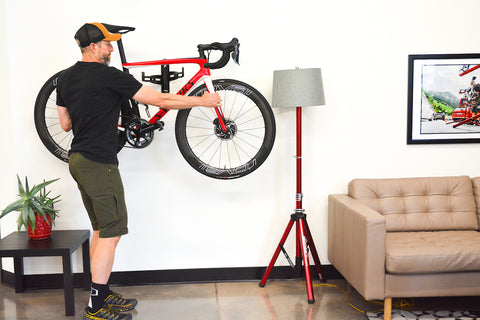Tips for Off-Season Bike Maintenance
Here is a step-by-step guide to off-season bike maintenance:
1. Clean your bike
The first step is to give your bike a good cleaning. This will remove any dirt, grime, and salt that has accumulated over the riding season.
To clean your bike, you will need:
- A bucket of soapy water
- A sponge or soft brush
- A hose or pressure washer
- A bike degreaser
Start by spraying the bike with water to loosen any dirt or grime. Then, use the sponge or brush to scrub the bike clean, paying attention to the drivetrain, brakes, and suspension components.
Once the bike is clean, rinse it with water and then dry it off with a clean towel.

2. Lubricate the drivetrain
The drivetrain is the system of components that transfers power from the pedals to the rear wheel. It is important to keep the drivetrain lubricated to prevent wear and tear and ensure smooth shifting.
To lubricate the drivetrain, you will need:
- A bike chain lube
- A lube applicator
- Apply a thin layer of chain lube to the chain, cassette, and chainrings. Be careful not to over-lubricate, as this can attract dirt and grime.
3. Inspect the brakes
The brakes are one of the most important safety features on your bike. It is important to inspect them regularly to make sure that they are working properly.
To inspect the brakes, check the brake pads for wear and tear. If the brake pads are thin or have any cracks, they need to be replaced. Squeeze the brake levers and note if they feel spongy or if they pull all the way to the handlebar. That's a sign they need professional service.
Also, check the brake cables or hydraulic brake hose to make sure that they are not frayed or damaged. If they are, they also need to be replaced.
4. Inspect the suspension
If your bike has a suspension fork or full-suspension system, it is important to inspect it regularly to make sure that it is working properly.
To simply inspect the suspension, check the forks and rear shock for any visible leaks or damage. If you see any evidence of leaks or visible damage to moving parts, you'll need professional service to identify and fix the problem.
Beyond just inspection, take note of the suspension component service intervals, as recommended by the manufacturer. It's a good idea to go ahead and have your suspension serviced before winter so you can start the next season in good working order.
Also, if you have a full suspension bike, you can remove the rear shock and check the frame linkage bearings to make sure that they are smooth and not binding. If they are, they need to be cleaned and lubricated, or possibly replaced.
5. Inflate the tires
Over time, tires tend to lose air pressure. It is important to inflate them to the correct pressure before each ride. The correct tire pressure is usually listed on the sidewall of the tire.
If you're using a tubeless tire system with sealant, it's a good idea to replace the sealant at least once per year. Doing so in the fall isn't the worst idea, but it might make more sense to just freshen up your tire sealant in the spring. Leaving it to sit idle all winter may cause it to dry out prematurely.
6. Store your bike in a cool, dry place
When you're not riding your bike, it is important to store it in a cool, dry place. This will help to prevent rust and corrosion.
In-home storage products like the Velo Cache, Velo Column, Velo Wall Rack 2D, and Velo Hinge make storing your bike a cinch.
If possible, store your bike indoors. If you have to store it outdoors, cover it with a bike cover.

7. Perform regular maintenance checks
Even if you don't ride your bike all that often, it is important to perform regular maintenance checks. This will help to identify any potential problems early on before they cause any damage.
At least once a month, check the following:
- Tire pressure
- Brake pads and cables
- Suspension forks and shock absorbers
- Drivetrain lubrication
- Shifting performance
- If you notice any problems, be sure to address them immediately.
Here are some additional tips for off-season bike maintenance:
- If you live in a cold climate, you may want to remove the battery from your e-bike and store it indoors.
- If you have a hydraulic suspension system, you may want to flush the brakes and suspension lines.
- If you have a carbon fiber bike, be sure to inspect it for any cracks or damage.
- If you are planning on storing your bike for an extended period of time, you may want to apply a coat of wax to the frame and components.
By following these tips, you can keep your bike running smoothly for many years to come.


